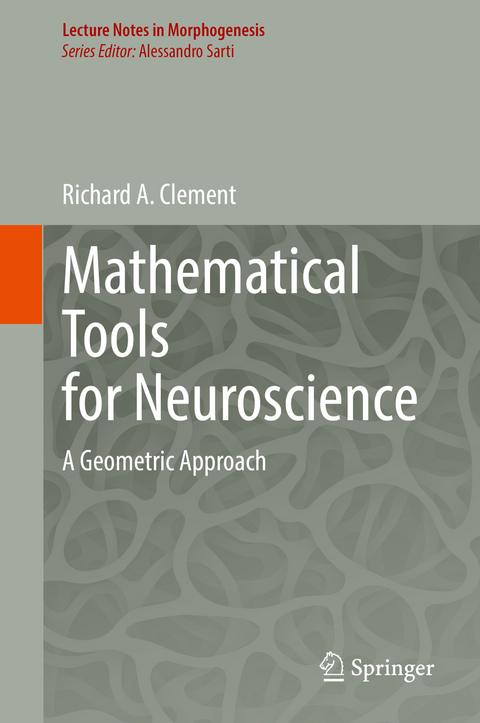
Mathematical Tools for Neuroscience
Springer International Publishing (Verlag)
978-3-030-98494-6 (ISBN)
If you record the eye movements of a group of people watching a riverside scene then some will look at the river, some will look at the barge by the side of the river, some will look at the people on the bridge, and so on, but if a duck takes off then everybody will look at it. How come the brain is so adept at processing such biological objects? In this book it is shown that brains are especially suited to exploiting the geometric properties of such objects.
Central to the geometric approach is the concept of a manifold, which extends the idea of a surface to many dimensions. The manifold can be specified by collections of n-dimensional data points or by the paths of a system through state space. Just as tangent planes can be used to analyse the local linear behaviour of points on a surface, so the extension to tangent spaces can be used to investigate the local linear behaviour of manifolds. The majority of the geometric techniques introduced are all about how to do things with tangent spaces.
Examples of the geometric approach to neuroscience include the analysis of colour and spatial vision measurements and the control of eye and arm movements. Additional examples are used to extend the applications of the approach and to show that it leads to new techniques for investigating neural systems. An advantage of following a geometric approach is that it is often possible to illustrate the concepts visually and all the descriptions of the examples are complemented by comprehensively captioned diagrams.
The book is intended for a reader with an interest in neuroscience who may have been introduced to calculus in the past but is not aware of the many insights obtained by a geometric approach to the brain. Appendices contain brief reviews of the required background knowledge in neuroscience and calculus.
Richard Clement is especially interested in the interplay between mathematics and experimental findings in neuroscience. After an initial period of research in vision and eye movements he moved to the UK government owned Defence Evaluation and Research Agency at first working on biologically inspired machine vision and subsequently on nonlinear dynamics of electronic circuits. He then moved to the Institute of Child Health of University College, London, to apply nonlinear dynamics to eye movements recorded from infants at Great Ormond Street Hospital. After retirement, he worked part-time as an associate lecturer in mathematical modelling at the Open University whilst continuing developing the ideas in this book as an honorary research fellow in the mathematics department at Exeter university.
- 1. Mind and Brain. - 2. Biological Objects. - 3. Measurements. - 4. From Local to Global. - 5. Actions. - 6. Brain and Body. - 7. Analysis of Experimental Measurements. - 8. Where Are We Going With All This?. - 9. Appendix: Background Material.
"The monograph is exclusively professionally written and the materials are presented in an attractive way. Obviously, research in this important scientific direction can be successfully expanded with the inclusion of specialized software tools implemented in computer algebraic systems designed for scientific calculations." (Nikolay Kyurkchiev, zbMATH 1496.92001, 2022)
“The monograph is exclusively professionally written and the materials are presented in an attractive way. Obviously, research in this important scientific direction can be successfully expanded with the inclusion of specialized software tools implemented in computer algebraic systems designed for scientific calculations.” (Nikolay Kyurkchiev, zbMATH 1496.92001, 2022)
| Erscheinungsdatum | 24.04.2022 |
|---|---|
| Reihe/Serie | Lecture Notes in Morphogenesis |
| Zusatzinfo | X, 162 p. 121 illus., 106 illus. in color. |
| Verlagsort | Cham |
| Sprache | englisch |
| Maße | 155 x 235 mm |
| Gewicht | 415 g |
| Themenwelt | Informatik ► Weitere Themen ► Bioinformatik |
| Mathematik / Informatik ► Mathematik ► Angewandte Mathematik | |
| Naturwissenschaften ► Biologie ► Humanbiologie | |
| Naturwissenschaften ► Biologie ► Zoologie | |
| Schlagworte | Arm Movements • Betti Numbers • colour vision • Delay Embedding • eye movements • Falling Cat • fibre bundle • geodesic • Hebbian learning • Heteroclinic Cycles • Hopf Bifurcation • Morse Theory • Neural Integrator • Slow-fast System • Visual cortex |
| ISBN-10 | 3-030-98494-X / 303098494X |
| ISBN-13 | 978-3-030-98494-6 / 9783030984946 |
| Zustand | Neuware |
| Haben Sie eine Frage zum Produkt? |
aus dem Bereich


